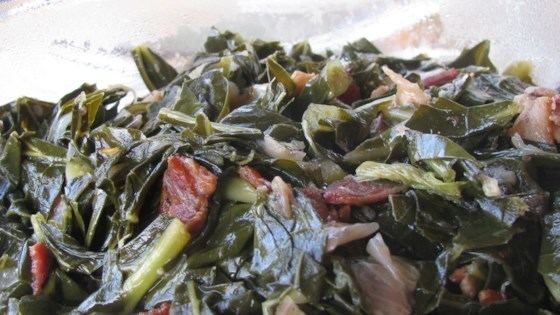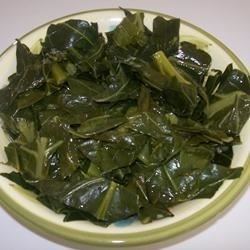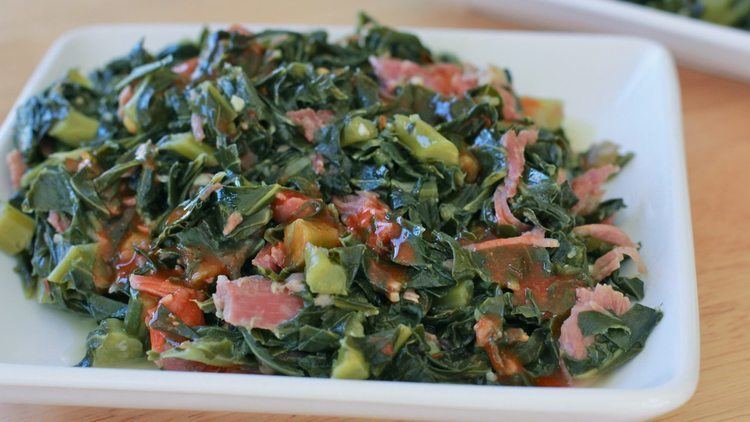Species Brassica oleracea Origin unknown | Cultivar group Acephala Group Cultivar group members Many; see text. | |
 | ||
Similar Kale, Cabbage, Broccoli, Leaf vegetable, Chard | ||
Collard greens 101 and recipe how to use make store quick and easy
Collard greens (collards) describes certain loose-leafed cultivars of Brassica oleracea, the same species as many common vegetables, including cabbage (Capitata Group) and broccoli (Botrytis Group). Collard greens are part of the Acephala Group of the species, which includes kale and spring greens. They are in the same cultivar group owing to their genetic similarity. The name "collard" is a corrupted form of the word "colewort" (the wild cabbage plant).
Contents
- Collard greens 101 and recipe how to use make store quick and easy
- Vegetarian southern collard greens recipe
- Description
- Cultivation and storage
- Nutritional information
- Culinary use
- Southern United States
- Tanzania and Kenya East Africa
- Brazil and Portugal
- Kashmir
- Pests
- References

The plants are grown for their large, dark-colored, edible leaves and as a garden ornamental, mainly in Brazil, Portugal, the southern United States, many parts of Africa, the Balkans, northern Spain and northern India.

Vegetarian southern collard greens recipe
Description

The cultivar group name Acephala ("without a head" in Greek) refers to the fact that this variety of B. oleracea does not have the close-knit core of leaves (a "head") like cabbage does. The plant is a biennial where winter frost occurs, and a perennial in colder regions. It is also moderately sensitive to salinity. It has an upright stalk, often growing up to two feet tall. The plant is very similar to kale. Popular cultivars of collard greens include 'Georgia Southern', 'Morris Heading', 'Butter Collard' (couve manteiga), and couve tronchuda.
Cultivation and storage

The plant is commercially cultivated for its thick, slightly bitter, edible leaves. They are available year-round, but are tastier and more nutritious in the cold months, after the first frost. For best texture, the leaves are picked before they reach their maximum size, at which stage they are thicker and are cooked differently from the new leaves. Age does not affect flavor. Flavor and texture also depend on the cultivar; the couve manteiga and couve tronchuda are especially appreciated in Brazil and Portugal.
Fresh collard leaves can be stored for up to 10 days if refrigerated to just above freezing (1°C) at high humidity (>95%). In domestic refrigerators, fresh collard leaves can be stored for about three days. Once cooked, they can be frozen and stored for greater lengths of time.
Nutritional information
Like kale, collard greens are very high in vitamin K (388% of the Daily Value). They are excellent sources (20% or higher of the Daily Value) of vitamin A, vitamin C, and manganese, and moderate sources of calcium and vitamin B6 (see table). A 100 g serving of cooked collard greens provides 33 calories, is 90% water, 3% protein, 6% carbohydrates and less than 1% fat (table).
Culinary use
Collard greens have been eaten for at least 2000 years, with evidence showing that the ancient Greeks cultivated several types of collard greens, as well as kale.
Southern United States
Collard greens is a staple vegetable in Southern U.S. cuisine. They are often prepared with other similar green leaf vegetables, such as kale, turnip greens, spinach, and mustard greens in the dish called "mixed greens". Typical seasonings when cooking collards are smoked and salted meats (ham hocks, smoked turkey drumsticks, pork neckbones, fatback or other fatty meat), diced onions, vinegar, salt, and black pepper, white pepper, or crushed red pepper, and some cooks add a small amount of sugar. Traditionally, collards are eaten on New Year's Day, along with black-eyed peas or field peas and cornbread, to ensure wealth in the coming year. Cornbread is used to soak up the "pot liquor", a nutrient-rich collard broth. Collard greens may also be thinly sliced and fermented to make a collard sauerkraut that is often cooked with flat dumplings.
Tanzania and Kenya (East Africa)
Collard greens are known as sukuma wiki in Tanzania and Kenya. Sukuma wiki is mainly lightly sauteed in oil until tender, flavoured with onions and seasoned with salt, and served either as the main accompaniment or as a side dish with the preferred meat (fish, chicken, beef, or pork). In Congo, Tanzania and Kenya (East Africa), thinly sliced collard greens are the main accompaniments of a popular dish known as sima or ugali (a maize flour cake).
Brazil and Portugal
In Portuguese and Brazilian cuisine, collard greens (or couve) is a common accompaniment to fish and meat dishes. They make up a standard side dish for feijoada, a popular pork and beans-style stew.
Thinly sliced collard greens are also a main part of the popular Portuguese soup, caldo verde ("green broth"). For this broth, the leaves are sliced into strips, 2–3 millimetres (0.079–0.118 in) wide (sometimes by a grocer or market vendor using a special hand-cranked slicer) and added to the other ingredients 15 minutes (900 s) before it is served.
Kashmir
In Kashmir Valley of India, collard greens (haak) are included in almost every meal, and both the leaves and roots are consumed. Leaves in the bud are harvested by pinching in early spring when the dormant buds sprout and give out tender leaves. Also, seedlings after 35–40 days (3,000–3,500 ks), as well as mature plants, are pulled out along with roots from thickly sown beds. When the extending stem bears alternate leaves in quick succession during the growing season, older leaves are harvested periodically. Before autumn, the apical portion of the stem is removed along with the whorled leaves.
The roots and leaves may be cooked together or separately. A common dish is haak rus, a soup of whole collard leaves cooked in water, salt and oil along with many other spices, and usually eaten with rice. Collard leaves are also cooked with meat, fish or cheese and in the winter, collard leaves and roots are fermented to form a very popular pickle called haak-e-aanchaar.
Pests
The sting nematode Belonolaimus gracilis and the awl nematode, Dolichodorus spp. are both ectoparasites that can injure collard. Root symptoms include, stubby or coarse roots that are dark at the tips. Shoot symptoms include, stunted growth, premature wilting and chlorosis (Nguyen and Smart, 1975). Another species of the sting worm: Belonolaimus longicaudatus is a pest of collards in Georgia and North Carolina (Robbins and Barker, 1973). B. longicaudatus is devastating to seedlings and transplants. As few as three nematodes per 100g of soil when transplanting can cause significant yield losses on susceptible plants. They are most common in sandy soils (Noling, 2012).
The stubby root nematodes Trichodorus and Paratrichodorus attach and feed near the tip of the tap roots of collard greens. The damage caused prevents proper root elongation leading to tight mats that could appear swollen, therefore resulting in a "stubby root" (Noling, 2012).
Several species of the root knot nematode Meloidogyne spp. are hosted by collards these include: (M. javanica, M. incognita and M. arenaria. Second stage juveniles attack the plant and settle in the roots. However, infestation seems to occur at lower populations compared to other cruciferous plants. Root symptoms include deformation (galls) and injury that prevent proper water and nutrient uptake. This could eventually lead to stunting, wilting and chlorosis of the shoots (Crow and Dunn, 2012).
The false root knot nematode Nacobbus aberrans has a wide host range of up to 84 species including many weeds. On Brassicas it has been reported in several states including Nebraska, Wyoming, Utah, Colorado, Montana, South Dakota, Kansas (Manzanilla- López et al., 2002). As a pest of collards, the degree of damage is dependent upon the nematode population in the soil.
